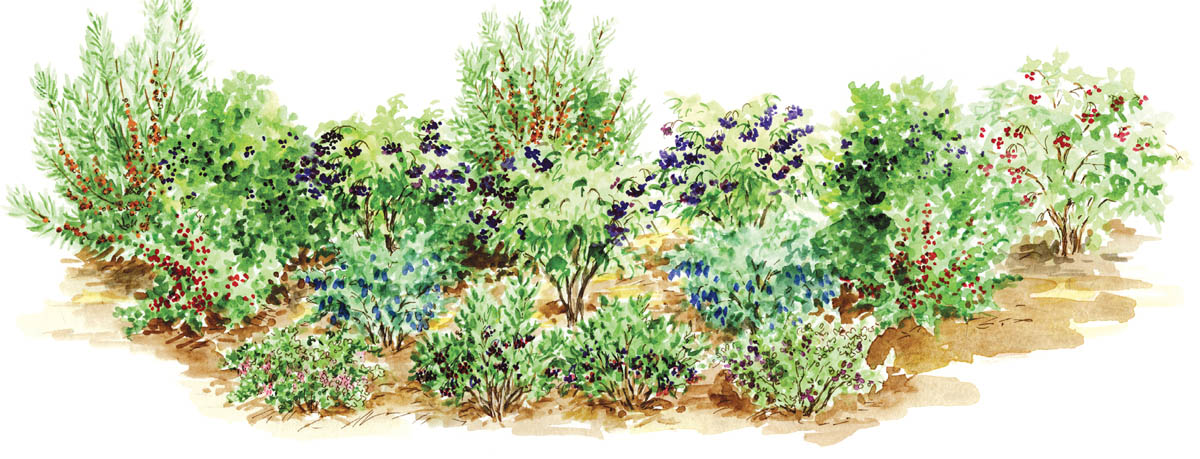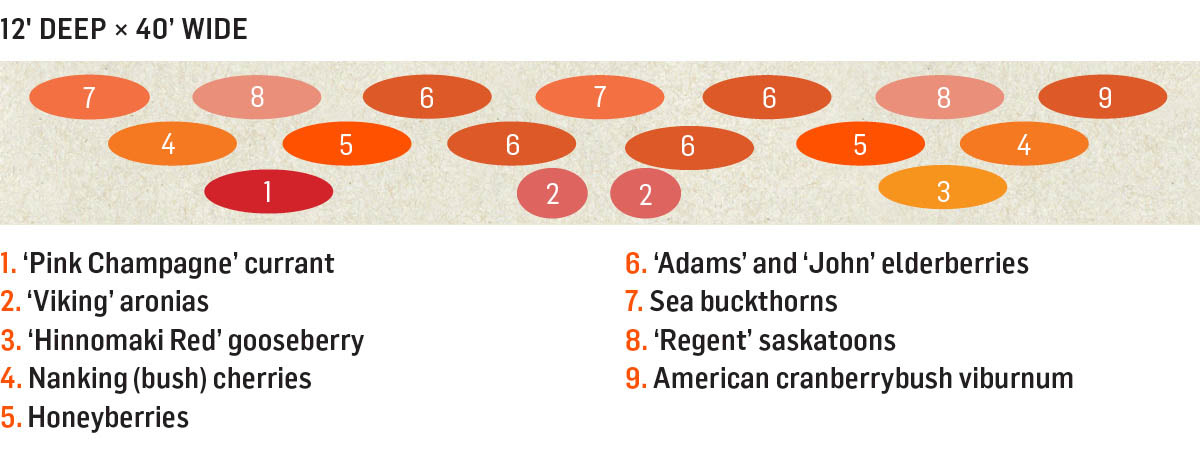
Looking for an ornamental or privacy hedge? Forget the privet and give Charlie Nardozzi’s hedge a try. His pleasing combination of native and introduced species creates a dense hedge that’s both low-maintenance and attractive, with the added bonus of producing tasty fruits like honeyberries, currants, and gooseberries over a long season.
A strong advocate of edible landscaping, Charlie Nardozzi has created a plan for an edible hedge that is both productive and ornamental, reminding us that with a little fresh thinking, we can grow edible plants in unexpected places. “An edible hedge is a great way to accomplish a number of landscaping goals, especially in a small space,” he says. “It provides screening from unwanted views, blocks access to your yard, provides habitat for birds and wildlife, and provides delicious berries that may be hard to fit in other places in your yard.”
Low-maintenance fruit. His design for a 40- by 12-foot deciduous hedge includes a range of hardy, vigorous plants that were carefully selected for their attractive foliage, form, and flowers — as well as their tasty fruits. Because the plants are arranged in a staggered formation, as they grow they will fill in any open spaces to create a dense hedge. The plan can easily be scaled down to fit a smaller site, or lengthened if space isn’t an issue and you want a longer privacy screen. “The beauty of an edible hedge made from native plants — or plants that are easy to grow in your landscape — is that they don’t require a lot of care to produce fruit,” Charlie says. Plus, many of Charlie’s picks are self-fruitful and require only one bush to yield a decent crop.
Before heading out to your local nursery, Charlie recommends taking a good look around your property to determine your growing conditions. How much sun does your location receive? Is the soil poor? Is it very windy and exposed? He says that most berry shrubs grow best with at least 6 hours of full sun and well-drained soil. Since many berry shrubs are tough and some are native, he adds that part sun and less-than-ideal soil would also work.
Gauge room for growth. While at the nursery, Charlie also advises carefully reading the plant tags, noting how tall and wide the plants will become at maturity. “Make sure you give them room to grow and plenty of space to ensure good air circulation, which reduces the possibility of disease,” he says. For a hedge, you will want the plants to grow closely, but you don’t want to overcrowd them and allow the branches to intertwine.
During the first season, Charlie suggests watering deeply every few weeks to help the plants establish successfully, but in subsequent years they should need only an annual application of compost. Removing any weeds will reduce competition for water and nutrients, and mulching with a layer of wood or bark chips will help keep weeds at bay. Remember that while the ‘Hinnomaki Red’ gooseberry may bear fruit the first year, most of the plants take a few years to establish and mature before they begin cropping.
Easy pruning. Pruning can be an intimidating task for many gardeners, but Charlie’s plants don’t require much fussing. “Pruning mostly consists of removing dead, diseased, broken, or crossing branches in spring,” he says. “Most of these shrubs won’t require any more extensive pruning.”
Why plant a strictly ornamental hedge when you can have one that combines beauty with a bounty of berries? The following plants were selected by Charlie for their hardiness, ease of cultivation, attractiveness, and of course — fruits!

‘Pink Champagne’ currant. A ‘Pink Champagne’ currant in full crop is truly a sight to behold, with its long chains of translucent berries brushed in soft pink. The bushy shrub will grow to be 3 to 5 feet tall. The plant is very disease-resistant, and because it’s self-pollinating, it doesn’t need a partner to ensure good fruit set. Use the fine-flavored fruits for jelly, pies, or fresh eating. Hardy in Zones 3 to 8. (May be restricted in some states because they are the alternate host for white pine blister rust.)
‘Viking’ aronias. ‘Viking’ is a productive cultivar of the native aronia that bears a late summer harvest of deep violet-black, pea-sized berries. The fruits hang in eye-catching clusters and can be eaten fresh, juiced, or baked into breads, muffins, and pies. The low-maintenance plants, which are self-fertile, grow to be 6 to 8 feet tall with glossy green leaves and a spring show of small white blooms. Hardy to Zones 3 to 8.
‘Hinnomaki Red’ gooseberry. For sheer productivity and outstanding tangy-sweet flavor, it’s hard to beat ‘Hinnomaki Red’ gooseberry. Small white flowers kick off spring, followed by pretty red fruits and eventually burgundy fall foliage. The compact plants are mildew-resistant and begin fruiting in the first year, making them an excellent choice for impatient gardeners! Eat the ripe berries out of hand, or use them for pies, jams, and jellies. Hardy in Zones 4 to 8. (May be restricted in some states because they are the alternate host for white pine blister rust.)
Nanking (bush) cherries. Nanking or bush cherry is an edible ornamental that tastes as good as it looks. The 8-foot-tall plants are smothered in charming soft pink flowers in late spring, and later bear a good harvest of sweet-tart fruits. Charlie has included two plants to ensure the highest yield. Hardy in Zones 2 to 7.
Honeyberries. In the past few years, honeyberries (also known as Haskap berries) have become a rather trendy plant, quickly selling out at nurseries and garden centers. Each shrub grows to be 4 to 6 feet tall and wide, depending on the variety. Honeyberry is disease- and insect-resistant, very cold hardy, and will thrive in difficult conditions, including moist and shaded sites. The elongated blueberry-like fruits can be eaten fresh or cooked in a variety of dishes. Hardy in Zones 3 to 8.
‘Adams’ and ‘John’ elderberries. Elderberry is a shrub native to North America, but the European species is also widely grown for its fruits. Although elderberry is considered to be partially self-fruitful, plant at least two cultivars for optimum yield. Charlie has selected ‘Adams’ and ‘John’ for their ease of cultivation and large clusters of tasty blue-black fruits. Each plant will grow to be 8 to 12 feet tall and provide pretty white flowers in the spring. The fruits are commonly used to make juice, jam, jelly, pie, and wine. Hardy in Zones 3 to 9.
Sea buckthorns. Sea buckthorn is a Russian species renowned for its juicy orange berries that are rich in vitamin C. It has the agreeable habit of thriving in a range of landscapes and can tolerate poor soil, as well as drought and salt. It will grow to be 6 to 18 feet tall. Because the plants are dioecious (there are separate male and female plants), you will need at least one male and one female plant. Hardy in Zones 3 to 7.
‘Regent’ saskatoons. Reaching a height of 6 to 10 feet, ‘Regent’ saskatoon is both decorative and high-yielding. In spring, the show starts with a flush of small white flowers, followed by a generous harvest of sweet, deep purple-black berries. The self-fruitful plants are resistant to diseases and insects, and their foliage turns a bright reddish yellow in autumn. The juicy fruits can be eaten fresh or cooked in jams and pies. Hardy in Zones 3 to 7.
American cranberrybush viburnum. A North American native, the American cranberrybush viburnum is an extremely hardy shrub that grows to be 8 to 12 feet tall. It is a beautiful addition to the landscape for much of the year. Beginning in spring, its white lacecap blooms open, followed by bright red berries in late summer and deep burgundy-purple leaves in autumn. The sour fruits can be used to make jam or cooked into sauces. Hardy in Zones 2 to 8.

1. ‘Pink Champagne’ currant
2. ‘Viking’ aronias
3. ‘Hinnomaki Red’ gooseberry
4. Nanking (bush) cherries
5. Honeyberries
6. ‘Adams’ and ‘John’ elderberries
7. Sea buckthorns
8. ‘Regent’ saskatoons
9. American cranberrybush viburnum